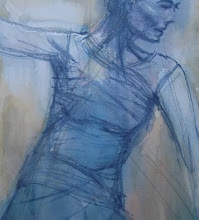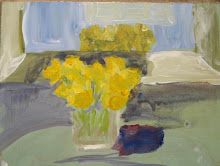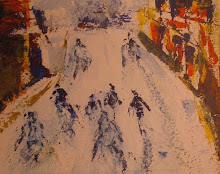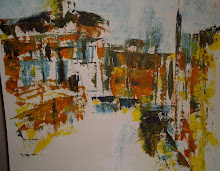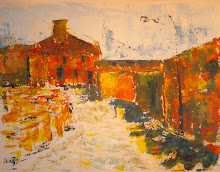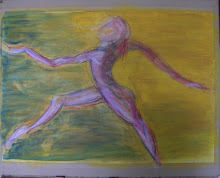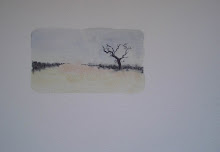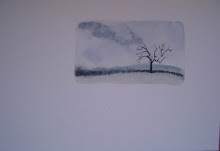On my return visit, all snow past, I take camera and sketchbook. A photo taken from the same place looks only vaguely like the scene I had tried to capture and keep in my memory. The trees in the wood are so small in comparison with the expanse of the field at the front of the picture.
I photograph and sketch some of the tree shapes – they stand against the sky with their structure revealed and demanding to be noticed.
Later when I change the tractor lines and add some foreground, I put in some trees that I saw to the right of the wood – the shapes are good but they are far too big – in the photo they are so small they can hardly be seen. In my painting they might work if they were half the size or less. But I like the painting despite this - because I looked so carefully at how the snow lay on the trees and around the wood, the painting acts as a prompt to a memory that is deeper than usual.
Thursday 24 April 2008
Snow in April
On Sunday 6th April it snowed before I woke. I walked around the fields, and stopped at one point to look at the view as a possible picture, across fields with snowy tracks to the wood as a line on the horizon, the mass of the wood petering out into to individual trees against the sky. I looked hard and mentally noted: the horizontal layers of field, trees, clouds; the positioning of snow and the green on the field; the lines made by the tractors -- double lines coming towards me and white against the green of the new wheat; the dark blue green of conifers in the wood and the tiny bright green on the hawthorn bushes at the front edge of the wood; the grasses and Hawthorn twigs close to me and how they hold themselves against the background of field in the sky as if they were the tallest elements in view.
Back home after the work I try to sketch out the painting and put in the details I remember. It's not bad but the tracks across the field don't find their position. When I go back a few days later to check, I see that of course they meet at a vanishing point somewhere beyond the sky.
My memory needs training for the visual.
Back home after the work I try to sketch out the painting and put in the details I remember. It's not bad but the tracks across the field don't find their position. When I go back a few days later to check, I see that of course they meet at a vanishing point somewhere beyond the sky.
My memory needs training for the visual.
Tuesday 15 April 2008
Anemones
I bought anemones. I drew them in pencil, over several days, pushing, erasing, shaping, making the drawing ‘like’ an anemone. The anemones start to die but I keep them. On a sheet of watercolour paper, I place a wash of paynes gray, quite wet. It runs. I dab it with the sponge which lifts off some wash in splodges. This is not particularly attractive. It stays on the easel (yes, the easel) for a week. One day I want to paint the anemones on the sheet – the dripping gray somehow calls for them. The white splodges recall something of them.
Ultramarine and Rose mix into the purple and the pink of anemones. The earlier drawings inform what I do; I don’t copy them but I use them; doing them has familiarised my eyes and hands and the connections between them that form the shapes. Sunday morning before visiting my father fading away in the hospital, tears come as my brush makes an anemone on the drippy paper – a fading anemone. My sadness is making the painting. It becomes so powerful that I have to stop and leave it. When I come back and look at it, it is after all quite small and insignificant, fading into its background.
So the next day, I mix some more paint and work on the second and third flowers. I just want the three flowers – to add stems would not be right for it – unless perhaps drawn with pencil or charcoal.
The steroid injection took the pain out of my hand – wonderful. And sleeping all night without dead hands waking me.
In between the two anemone versions, I saw Nederlands Dans Theater in London - amazing skill at work. The middle piece was called ‘Signing Off’ and the music was Philip Glass’s Concerto for violin and orchestra; at the back of the stage were two huge lengths of dark silk that billowed forwards, in waves that moved down along the material and on to the stage. The music repeats its sad falling melody, more and more slowly, and the dancers move more slowly and gently, turning their backs to the audience, and disappear into the darkening silk, slowly fading from us. More emotion. My new friend perceptively remarked, "So, you've started mourning." The dance experience, the anemone painting experience, and the experience of holding my father’s hand as he disappears into his confusion meld together into mourning.
Ultramarine and Rose mix into the purple and the pink of anemones. The earlier drawings inform what I do; I don’t copy them but I use them; doing them has familiarised my eyes and hands and the connections between them that form the shapes. Sunday morning before visiting my father fading away in the hospital, tears come as my brush makes an anemone on the drippy paper – a fading anemone. My sadness is making the painting. It becomes so powerful that I have to stop and leave it. When I come back and look at it, it is after all quite small and insignificant, fading into its background.
So the next day, I mix some more paint and work on the second and third flowers. I just want the three flowers – to add stems would not be right for it – unless perhaps drawn with pencil or charcoal.
The steroid injection took the pain out of my hand – wonderful. And sleeping all night without dead hands waking me.
In between the two anemone versions, I saw Nederlands Dans Theater in London - amazing skill at work. The middle piece was called ‘Signing Off’ and the music was Philip Glass’s Concerto for violin and orchestra; at the back of the stage were two huge lengths of dark silk that billowed forwards, in waves that moved down along the material and on to the stage. The music repeats its sad falling melody, more and more slowly, and the dancers move more slowly and gently, turning their backs to the audience, and disappear into the darkening silk, slowly fading from us. More emotion. My new friend perceptively remarked, "So, you've started mourning." The dance experience, the anemone painting experience, and the experience of holding my father’s hand as he disappears into his confusion meld together into mourning.
Monday 7 April 2008
Painting tulips
A significant point. At last, at long last, I take the blue plastic box out of the drawer and meet again with my acrylics. Several trips up and down stairs - for the pliers to hold the lids and twist the tubes open, for the piece of natural sponge, dried up, for the plastic pot for water and the old plastic box lid I use as a palette that carries dried skins of former efforts. I choose the kitchen, but do not use the easel. Instead, newspaper on top of the island unit. It is thick oak, new, varnished, but still scary -- thick layers of newspaper to protect it, and one has an article about Howard Hodgkin’s new pictures, his red and green and yellow thick brushwork, a bon voyage wish underneath my picture. I tape a large sheet of watercolour paper, almost card, thick and white, on to my drawing board with masking tape. Each familiar ritual delights. Colours selected, squeezed on to palette - carmine red, naples yellow, sap green, paynes gray. Brush. I paint a dead tulip. Its petals have dried, shrunk, and twisted apart to reveal the black pistils and the swollen stamen. I love it; I love the painting I made. It sings out of the page. The accidental accuracies dance.
Later I add a purple tulip. This too was dying but the petals had stayed closed. It didn't work as well. I tried adding a dark dark grey background on one side, almost black. It helped but it still didn't really work.
I stand the picture on the drawing board under the window and walk to the other side of the kitchen to look at it. How wonderful is this? that something you've made, becomes slightly strange and slightly wonderful just by moving back across the kitchen.
Several days later, I work some more on the picture, having lived with it and thought about it, having watched it and looked at the spaces as I passed by. It had started like a rather wild and out of control Elizabeth Blackadder with an empty background, flowers placed on the paper separately rather composed as a bunch from the beginning. But now I thought that I should have painted a background as the first act. I added a daffodil from the bunch that a friend (a new friend - what a delight!) had given me at Easter. They were creamy white and double, treble, quadruple, with curly edged petals and dark orange insides. I painted roughly on the white paper and then the background could not any longer be resisted. A sludge of paynes gray with some white and a dash of ultramarine blue, large brush, edging round the wild red tulip and then using a damp sponge to retain its brightness where grey had invaded naples yellow or carmine red. Then the daffodil again, this time trying to use the grey as shadow as well as background. Not bad -- the frothy feel was there. Then one of the miniature wild daffodils that I had planted along the bank by the pond and that had not been eaten by the geese. Tiny delicate see-through, a limey lemony yellow and pale pale lemony white. When I stand back at the other side of the room, I love it, even though I can see the petals are not quite in the right place - they wouldn't close up properly if time ran backwards and the flower became bud.
I stand the painting, still taped to the board, in the fireplace where the black painted wall acts as a suitable backdrop. I like to catch sight of it by accident and see if I can find anything new to look at. The tape begins to curl off so I carefully remove it, leaving the white framing edge that pleases me.
Later I add a purple tulip. This too was dying but the petals had stayed closed. It didn't work as well. I tried adding a dark dark grey background on one side, almost black. It helped but it still didn't really work.
I stand the picture on the drawing board under the window and walk to the other side of the kitchen to look at it. How wonderful is this? that something you've made, becomes slightly strange and slightly wonderful just by moving back across the kitchen.
Several days later, I work some more on the picture, having lived with it and thought about it, having watched it and looked at the spaces as I passed by. It had started like a rather wild and out of control Elizabeth Blackadder with an empty background, flowers placed on the paper separately rather composed as a bunch from the beginning. But now I thought that I should have painted a background as the first act. I added a daffodil from the bunch that a friend (a new friend - what a delight!) had given me at Easter. They were creamy white and double, treble, quadruple, with curly edged petals and dark orange insides. I painted roughly on the white paper and then the background could not any longer be resisted. A sludge of paynes gray with some white and a dash of ultramarine blue, large brush, edging round the wild red tulip and then using a damp sponge to retain its brightness where grey had invaded naples yellow or carmine red. Then the daffodil again, this time trying to use the grey as shadow as well as background. Not bad -- the frothy feel was there. Then one of the miniature wild daffodils that I had planted along the bank by the pond and that had not been eaten by the geese. Tiny delicate see-through, a limey lemony yellow and pale pale lemony white. When I stand back at the other side of the room, I love it, even though I can see the petals are not quite in the right place - they wouldn't close up properly if time ran backwards and the flower became bud.
I stand the painting, still taped to the board, in the fireplace where the black painted wall acts as a suitable backdrop. I like to catch sight of it by accident and see if I can find anything new to look at. The tape begins to curl off so I carefully remove it, leaving the white framing edge that pleases me.
Subscribe to:
Posts (Atom)
